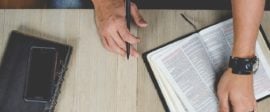Music, Christian
Book / Produced by partner of TOW
God delights in music; Scripture repeatedly endorses it. The Old Testament abounds with indirect as well as detailed references to its use. The song of Miriam recorded in Exodus 15:21 and the account of the ceremonial inauguration of Solomon’s newly built temple in 2 Chron. 5:12-13 are just two glimpses of different uses of music as a response to, and worship of, God. As well as encouragement to break into song as a private response to God, we are given a rich deposit of psalms, which have nourished and served God’s people through the ages.
By contrast, the New Testament has very little to say about the subject. Other than a few indirect references—such as the trumpet sounding at the resurrection of the dead (1 Cor. 15:52)—Paul’s injunction to “speak to one another with psalms, hymns and spiritual songs” (Ephes. 5:19) is as specific as it gets, and this passage is open to a variety of interpretations. Nevertheless, it is clear that music is a universal gift from God without which our world, as well as our worship, would be greatly impoverished.
One could argue that there is no such thing as Christian music any more than there is Christian air or Christian food. The musical practices we read of in the Old Testament employed idioms and instruments held in common with the pagan civilizations around them. Yet when we dedicate universal gifts like this solely to God’s glory, the transforming power of the Holy Spirit turns them into something unique, ministering to individuals and congregations at a profoundly spiritual level. We do have a vital role in this process, and the extent of the transformation, if history is a reliable judge, depends very much on how much thought, effort and integrity we ourselves bring to the music we are offering.
World Music and Western Music
Today’s non-European cultures nearly all seem to enjoy a common language of music, which is woven into the fabric of life, just as it was an integrated part of Jewish society. In non-Western and African-American cultures, singers, dancers and drummers carry from one generation to another a commonly understood musical language that seems able to adapt to every mood, from celebration to mourning. Christians in these cultures are increasingly grafting indigenous music into their worship. In a different vein, churches of the Eastern Orthodox tradition, notably the Greek and Russian branches, make a sharp distinction between secular and sacred, preserving a distinctive and rich musical tradition for worship. In these systems music takes its designated place naturally—it knows when to pipe up and when to keep silent.
For better or worse, this kind of stability is not a characteristic of Western music. Through the centuries its progress has been increasingly restless and subject to rapid development and, more recently, fragmentation. It has also become commercially marketed and has grown to a point where today we face an overwhelming smorgasbord of classical and popular styles, not unlike a multichannel cable system. One consequence of this postmodern diversity is that Christians are unable to agree upon a unified musical language—a situation that could be seen as healthy diversity but that more typically encourages uncritical standards and reinforces division.
We can understand better how we reached this point by looking at how Christian music developed; there may even be clues in it for molding a distinct, unified music for the future. The story of music from the early church up to the present day acts as a kind of mirror. Much like an archaeological site, it reveals how music was used and shaped at different periods. It reveals successes and failures. Like all history, it keeps us humble by reminding us that the latest is not always the best. Indeed, there have been times of remarkable wisdom and holiness in the church that we will always do well to reflect upon.
Looking at the Time Line
Any serious textbook dealing with the history of European music reads at first (often for several chapters) like a history of church music. All that we take for granted in music—our tonal system, rhythmic conventions, the means by which we write down music—was cradled and nourished within the church. Despite the growth of humanism and the expansion of secular music in the Renaissance, the church remained a vital focus of musical activity until the middle of the eighteenth century. We can trace this in the style of music that prevailed until roughly 1750: plainchant, motets, anthems, liturgical settings, organ music, cantatas, oratorios and so on, alongside a smaller, but growing, body of secular song and instrumental music.
As we examine this archaeological dig of musical history, we can sense a historic tension between artists and church authority. There is a recurring concern about the sensual lure of music—its ability to dominate worship and obscure, rather than illuminate, the Word. Augustine, sundry popes and bishops, Martin Luther, John Calvin, the Puritans, modern evangelicals, charismatic leaders and Vatican II have all expressed this concern in one way or another.
In its concern for purity of worship, Calvinism legislated musical austerity in church worship. Only the psalms were permitted, sung in unison without accompaniment. The Puritans applied the same tradition in England and brought it to the New World. Instruments were out of the question, and even the pipe organ was a problem. On the Continent the Calvinists discouraged or forbade it; in England organs were sometimes physically destroyed. Yet despite the severity of this approach, there can be great beauty in simple, plain music, and this ascetic musical tradition is still greatly valued in certain branches of the Presbyterian Church.
In contrast to the Calvinist tradition, Martin Luther’s affirmative view of music fostered one of the richest musical movements in Protestant culture. Here we discover music designed to glorify God and incorporate all people, not just a select few. It is centered on the Lutheran chorale, which draws from a wide range of sacred and secular melodies and is the basis of our modern congregational hymnody. The movement arising from Luther became the framework for exciting new music by Protestant composers who dedicated their work to the church: Jan Sweelinck, Heinrich Schutz, Johann Pachelbel and Dietrich Buxtehude, to name just a few. At the height of this era one figure stands out supremely—Johann Sebastian Bach (1685-1750).
A combination of superlative skill, extraordinary energy and evident Christian commitment gives Bach’s music an unusual degree of integrity and attractiveness. His nearly two hundred cantatas for the church, his moving settings of Christ’s passion (from St. Matthew and St. John), the great B Minor Mass and his organ chorale preludes reveal not only a vibrant personal faith but also a thorough understanding of theology as well as consummate skill. In the society in which Bach lived, rigorous, disciplined training was a prerequisite to musical leadership, particularly in the church; good ideas were not enough.
Music really does reveal a lot, but the poetry set to it perhaps reveals even more: early Latin hymn texts stressing God’s holiness and majesty; sixteenth-century texts focusing on our unworthiness, the hymns of Charles Wesley and Isaac Watts full of assurance and the prospect of eternal life. An unquestioned trinitarian belief and a clear view of the human condition shine through the words and music of these periods leading up to the turbulent nineteenth century. It is fascinating to see what happened next.
Bach died in 1750, and Handel—also a profoundly Christian musician—died shortly thereafter. Observing what followed, we can see how the character of Christian music was unlikely to be the same again. The influence that the church had for so long exerted upon the course of music and art dropped away. The character of music changed abruptly as the focus moved from the church to the concert hall and the opera house. Music could not consider itself primarily Christian any longer, because all of its exciting new developments were taking place outside the church’s sphere of influence.
We can trace how the church retreated from an increasingly hostile secular world to create its own in-house art and music: typically a sentimental, otherworldly type of expression, which has held sway in the churches up to the present day. Looking at a chorus collection of the later nineteenth century, such as Ira D. Sankey’s Sacred Songs and Solos, we see the impact of mass production on Christian music. It became a widely disseminated, prepackaged, functional and pietistic product. Of course, there are even within these stylistic confines some attractive and effective compositions that have rightly survived the test of time, but the overall quality of music during this period reflects a general decline in the fortunes of spiritual music.
Today and the Future
What will future generations make of our present-day music? There will be those compositions whose distinctive content and careful crafting will have secured them a permanent place in the Christian repertoire. But on a broader scale, future generations will probably observe that whereas the church once shaped secular culture, our contemporary worship music has been largely shaped by the commercial world. They might well lament the absence of a more authentic and durable kind of music that might have been passed from generation to generation with some pride. They will wonder—as we should—why original, creative, thoughtful options tended to be ignored in favor of commercially and technologically driven products. But there are more profound issues that go to the heart of the matter.
In its more distinguished periods Christian music has been marked by a confluence of excellence and humility. Excellence is human endeavor at its best, regardless of the simplicity or complexity of the task. Humility involves a servant-like attitude, a realization that there is always room for improvement and that history has much to teach us. The two should be held together by an acknowledgment that none of it will bear fruit without God’s grace and blessing. This is not to imply that humility is wholly absent today or that there is no genuinely creative work by individual Christian musicians working in the popular genre. The challenge, however, for all Christians working in the musical domain is how to keep ego out of the equation, for it will do its best to emerge somehow.
In so-called formal music the dangers lie in using specialized training and aesthetic judgment to adopt a position of superiority within the fellowship. Nothing alienates people more effectively, and the discouragement of fine music in our churches has undoubtedly come about largely because of this tendency. Different dangers, ones much closer to the surface, lurk in the commercially influenced popular idioms. Here the music from the outset has been designed to draw upon easily tapped and easily manipulated emotions; the power placed in the hands of leaders and composers working in this genre thus requires extremely thoughtful control if a manipulative and sometimes sensual dynamic is not to be confused with the workings of the Holy Spirit.
When music is transformed by God’s grace, it becomes distinctive and ministers to individuals and congregations at a profoundly spiritual level going far beyond mere entertainment. It can reinforce truth and fellowship and even offer brief glimpses of an eternal glory that we will one day share in the presence of the Lord God himself. Our part is to ensure that we bring—like the sacrificial offerings of old—only the very best for God to bless.
» See also: Culture
» See also: Music
» See also: Worship
References and Resources
H. M. Best, Music Through the Eyes of Faith (San Francisco: Harper, 1993); D. P. Hustad, Jubilate II—Church Music in Worship and Renewal (Carol Stream, Ill.: Hope Publishing, 1993); A. Wilson-Dickson, The Story of Christian Music (Batavia, Ill.: Lion, 1992).
—Edward Norman





